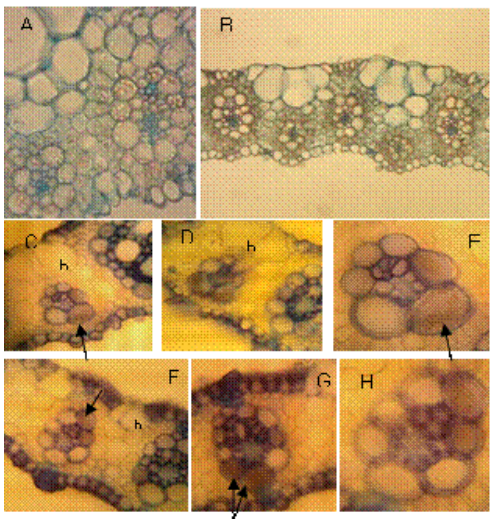Caracterización fitopatológica, histológica y molecular de la interacción gluconacetobacter diazotrophicus-xanthomonas albilineans-caña de azúcar
Contenido principal del artículo
Resumen
La búsqueda de resistencia a enfermedades por diferentes vías reviste especial importancia en las estrategias de manejo para una agricultura cañera sostenible. En este sentido se ha informado, en estudios in vitro, el potencial de Gluconacetobacter diazotrophicus (Gd) como antagonista de Xanthomonas albilineans (Xa). El objetivo de este trabajo fue caracterizar fitopatológica, histológica y molecularmente la interacción endófito-caña de azúcar-patógeno. Se emplearon los cultivares C1051-73 y C90-469, con cuatro tratamientos: control sano, plantas inoculadas con Xa, plantas inoculadas con Gd y plantas inoculadas con Gd y Xa. Se realizaron muestreos mensuales y se registró el número de plantas con síntomas por tratamiento y réplica de cada cultivar hasta los cuatro meses posteriores a la inoculación. La presencia de Xa y Gd se detectó por PCR específico y los cambios histológicos con cortes transversales. Se demostró la patogenicidad X. albilineans, así como la efectividad de la inoculación, por el desarrollo de síntomas típicos de escaldadura foliar de la caña de azúcar, en el control de infección del cultivar susceptible C1051-73. En el resto de los tratamientos no se detectó Xa, lo que coincide con la acumulación de una sustancia refringente en las células del parénquima que rodean los haces vasculares. Se observó la disminución de la intensidad del fragmento de ADN específico de Xa amplificado por PCR, ya que la acción de Gd sobre Xa puede haber ocasionado que la bacteria no pudiera establecerse en la planta.
Detalles del artículo

Esta obra está bajo una licencia internacional Creative Commons Atribución-NoComercial 4.0.
Citas
Arencibia, A., Estevez, Y., Vinagre, F., Bernal, A., Perez, J., Carmona, E., Hemerly, A., & Santana, I. (2006). Induced-resistance in sugarcane against pathogenic bacteria Xanthomonas albilineans mediated by an endophytic interaction. Sugar Tech, 8(4), 272-280, ISSN: 0974-0740.
Cavalcante, V. A., & Dobereiner, J. (1988). A new acid-tolerant nitrogen-fixing bacterium associated with sugarcane. Plant and soil, 108(1), 23-31, ISSN: 1573-5036.
Compant, S., Clément, C., & Sessitsch, A. (2010). Plant growth-promoting bacteria in the rhizo-and endosphere of plants: Their role, colonization, mechanisms involved and prospects for utilization. Soil Biology and Biochemistry, 42(5), 669-678, ISSN: 0038-0717.
D’Ambrogio de Argüeso, A. (1986). Manual de técnicas en histología vegetal. Hemisferio Sur, Buenos Aires, Argentina.
Debes, M. A. (2013). Mejoramiento vegetal de frutillas (Fragaria x ananassa) a partir de germoplasma silvestre relacionado [Tesis presentada en opción al grado científico de Doctor en Ciencias Biológicas]. Universidad Nacional de Tucumán (UNT), Facultad de Ciencias Naturales e Instituto Miguel Lillo (INSIBIO-CONICET), Tucumán, Argentina.
González, R., Carvajal, O., Tamayo, M., Montalván, J., García, J. H., Pérez, J. R., Jorge, H., Mesa, J. M., Puchades, Y., & Barroso, G. (2010). Método de evaluación de la resistencia a la escaldadura foliar de la caña de azúcar en Cuba. Revista Cuba & Caña, 1, 27-35, ISSN: 1028-6527.
Jorge, H., Jorge, I. M., Mesa, J., & Bernal, N. (2011). Normas y Procedimientos del Programa de Fitomejoramiento de la Caña de Azúcar en Cuba [Ediciones PUBLINICA, La Habana, Cuba, pp. 308-346.].
Kirchhof, G., Baldani, J. I., Reis, V. M., & Hartmann, A. (1998). Molecular assay to identify Acetobacter diazotrophicus and detect its occurrence in plant tissues. Canadian Journal of Microbiology, 44(1), 12-19, ISSN: 0008-4166.
Kloepper, J. W., & Ryu, C.-M. (2006). Bacterial endophytes as elicitors of induced systemic resistance (Schulz BJE, Boyle CJC&Sieber TN). Springer-Verlag, Berlin, Germany.
Loiret, F. G., Ortega, E., Ortega, R. P., Rodés, R., & De la Fuente, E. (2004). Gluconacetobacter diazotrophicus es todavía un dilema para la ciencia. Revista Biología, 18(2), 113-122.
Perez, A. N., & Tomasi, V. H. (2002). Tinción con azul brillante de cresilo en secciones vegetales con parafina. Bol. Soc. Argentina Botánica, 37, 211-215, ISSN: 0373-580X.
Piñón, D., Casas, M., Blanch, M., Fontaniella, B., Blanco, Y., Vicente, C., Solas, M. T., & Legaz, M. E. (2002). Gluconacetobacter diazotrophicus, a sugar cane endosymbiont, produces a bacteriocin against Xanthomonas albilineans, a sugar cane pathogen. Research in Microbiology, 153(6), 345-351, ISSN: 0923-2508.
Rott, P., Soupa, D., Brunet, Y., Feldmann, P., & Letourmy, P. (1995). Leaf scald (Xanthomonas albilineans) incidence and its effect on yield in seven sugarcane cultivars in Guadeloupe. Plant pathology, 44(6), 1075-1084, ISSN: 0032-0862.
Sánchez, B. A., León, G. de A. D., Aranda, O. S., Zavaleta, M. E., Nava, D. C., Goodwin, P. H., & Leyva, M. G. (2018). Bacterias endófitas de la raíz en líneas de maíces tolerantes y susceptibles a sequía. Revista mexicana de fitopatología, 36(1), 35-55, ISSN: 0185-3309, DOI: https://dx.doi.org/10.18781/R.MEX.FIT.1710-3
